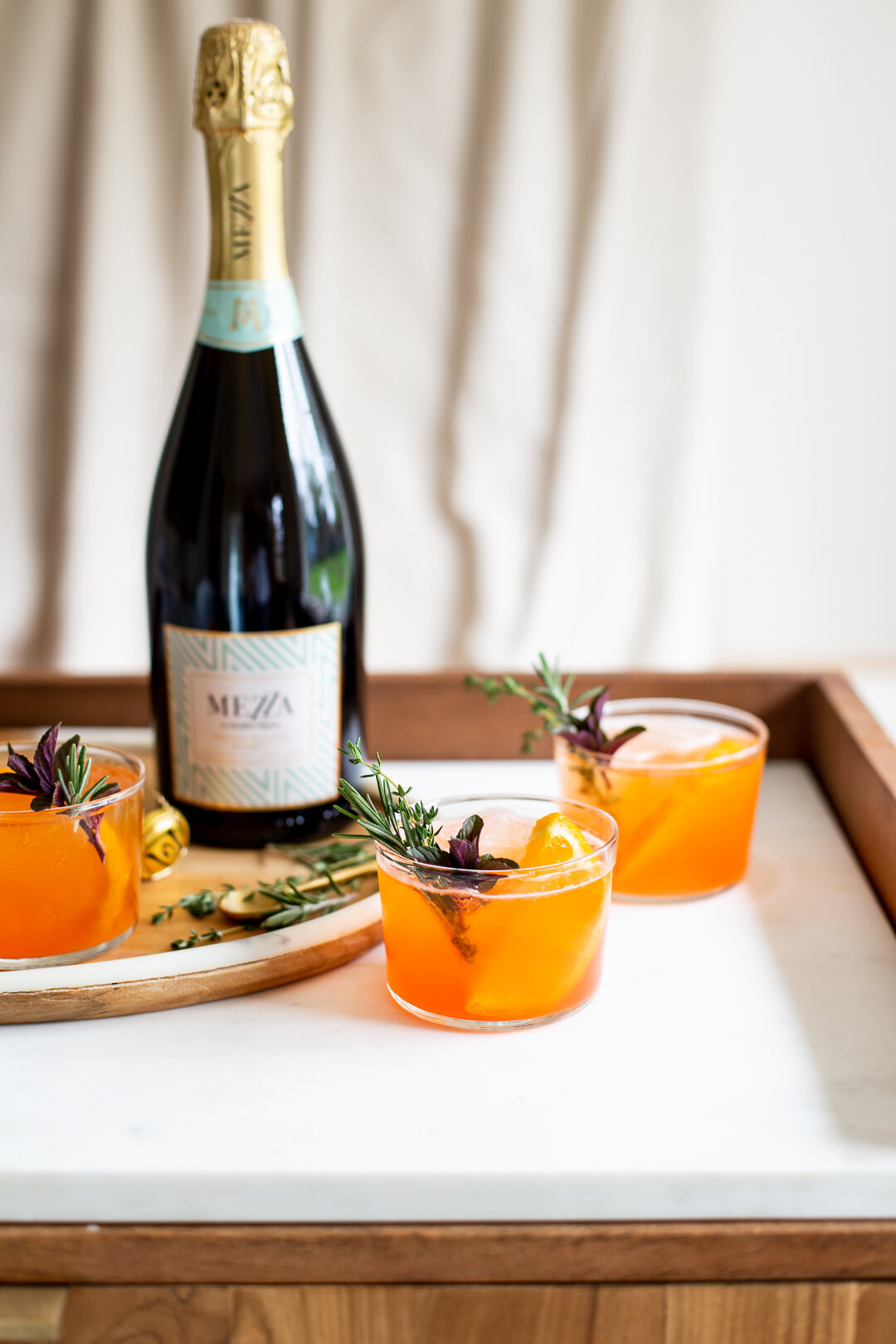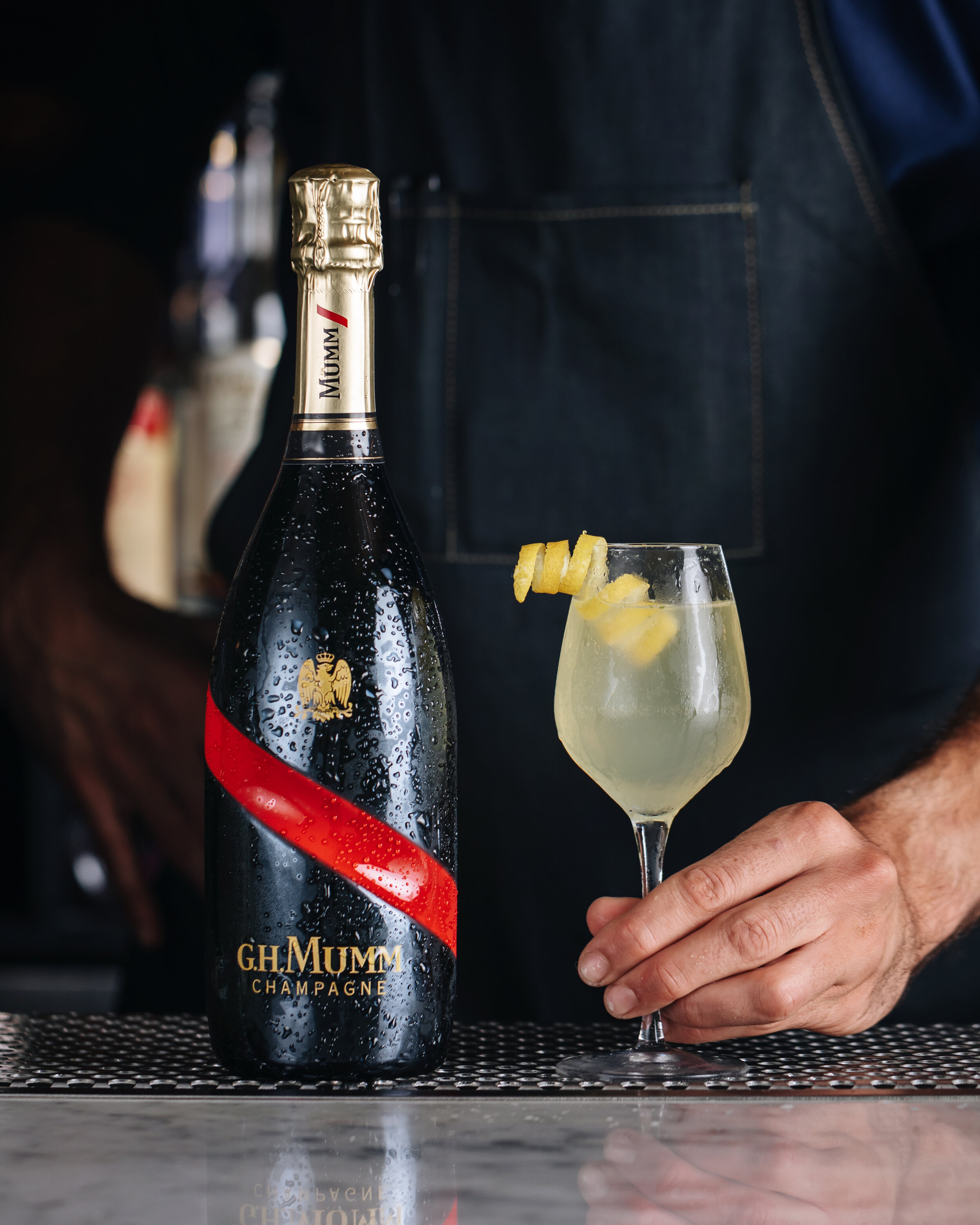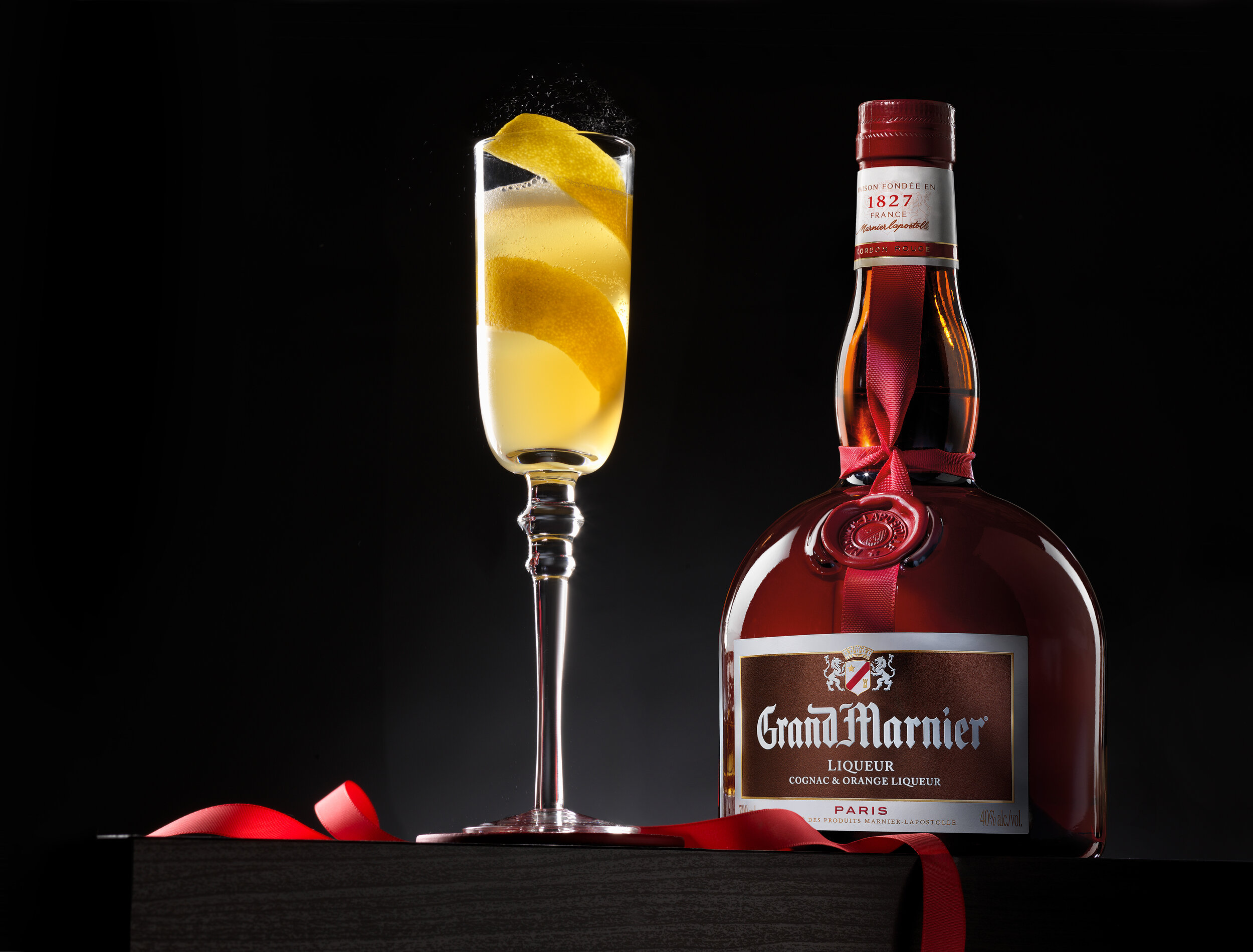Sparkling Wine Cocktails 101
courtesy Chandon
Find the right bubbly for all your fizzy libations
Cocktails that start with bubbly have a knack for showing off a drink’s other ingredients, turning up the volume on aromatics and flavor while prepping the palate for another sip. “Sparkling wine cocktails can be some of the most complex, flavorful cocktails out there with just a couple of pours,” says Colleen Jeffers, photographer and author of the book Bubbly: A Collection of Champagne and Sparkling Cocktails. “Sparkling wine brings acidity to the table in the form of tartaric and lactic acid [and] the sharp texture of carbonation, which means you’re already halfway to the sugar/acid balance that augments most great cocktails.” For maximum effect though, don’t just grab any wire cage-enclosed bottle. While it’s true that you can’t go wrong with a splash of any effervescence, find one that pairs with the produce, spirits, juices, syrups and bitters that are sharing space in that coupe or rocks glass.
Note: these wines match the cocktails, but are all also great sippers served chilled on their own.
Sparkling Rosé
Whether you are uncorking a bottle of Cava Rosado, new world brut rosé from California, or a crémant brut rosé from the Loire, pink makes cocktails pop, and you only need to look to its hue for a clue about what to mix with it. Strawberries, raspberries, watermelon and ruby red grapefruit will coax out the similar aromas and flavors in the wine, not to mention ramp up that pretty color. You can also use similarly-hued liqueurs, spirits or bitters with those flavors as a modifier, including Chambord (or other berry liqueurs), pink gin or a bright amaro like Ramazzotti.
Bottles to try:
Poema NV Brut Rosé Cava ($13) is made with the rare varietal trepat native to Catalonia, which has aromas of strawberry, raspberry and rose petals along with balanced acidity to keep the wine light and fresh. This was a Double Gold medal winner at the 2019 New York International Wine Competition.
Chandon Rosé ($19) is a dry and elegant traditional method expression from California made with chardonnay and a touch of pinot noir, with notes of ripe strawberry, juicy watermelon and raspberry, a creamy mouthfeel and a long yet fresh finish.
2017 Arrington Vineyards Sparkle the Rosé ($40): This Tennessee, (YES, Tennessee!), wine is made with chambourcin, sangiovese and corot noir, making it refreshing and dry, with aromas of salted watermelon and cranberry and flavors of citrus and red apple. This was a silver medal winner at the 2019 New York International Wine Competition.
Watermelon Spritz
Recipe by Lynnette Marrero for Chandon
The problem with buying a whole watermelon is figuring out what to do with all of it. Reserve some of it for this refreshing spritz recipe, which uses chunks or purée. To make it, choose a bright and fruity rosé, such as the Chandon. The drink can also be batched ahead of time and kept in a pitcher in the refrigerator (but sans the bubbly) until ready to serve. “A lot of the time people are drinking sparkling wine it is for some type of celebration, so keep it light, fun, and cold, says Charlotte, North Carolina-based bartender JaQuan Bowser.
4 large chunks of watermelon or 3 oz. watermelon purée
½ oz. simple syrup (can substitute agave or another sweetener)
½ oz. lime juice
5 mint leaves
3 oz. chilled Chandon Brut rosé, or other similar style
Slice of watermelon and mint sprig, for garnish
Add the watermelon and mint to a cocktail shaker and muddle gently. Add the lime juice and simple syrup, add ice and shake until well-chilled. Double-strain into a wine glass over fresh ice, top with the chilled sparkling wine, stir gently and garnish with the watermelon and mint.
Pink Fizz
Recipe courtesy of Beefeater Gin
This drink uses a new expression from the London Dry Gin producer that’s flavored with natural strawberry—an homage to distillery founder James Burrough who was known to stroll through London’s Covent Garden in the 1800s picking up ingredients to experiment with new gin and liqueur flavors. It’s perfect mixed with the sweet tang of pomegranate juice and a pink sparkling wine.
2 oz. pomegranate juice
1 oz. sparkling rosé
⅓ oz. St.-Germain or other elderflower liqueur
¼ oz. lime juice
Sparkling water, to top (optional)
Mint, lime wheel and pomegranate seeds, for garnish
Build the drink in a rocks glass or wine goblet over ice, top with the sparkling wine and water. Stir gently and garnish as desired.
photo courtesy Mezzacorona
Prosecco
Italy’s wildly popular bubbly style is made with the charmat method, where it undergoes the secondary fermentation that gives it effervescence in a large tank rather than in bottles. This results in soft bubbles and a sweeter profile that makes Prosecco so easily quaffable. Because it lacks the signature yeasty, bready notes found in Champagne and other traditional method sparkling wines, Prosecco can be viewed like a blank canvas for a whole host of ingredients. It’s the bubbly of choice in a traditional Spritz, where its sweetness offsets the bitterness of Aperol or Campari, and combining it with other tart or bitter ingredients like Rhuby Rhubarb Liqueur accomplishes the same goal. But if you prefer your cocktails on the sweeter side, just add your favorite fresh fruit juice or purée (such as in a Bellini with peaches) or sweet liqueur. It really is effortlessly mixable.
Bottles to try:
Sterling Vintner’s Collection Prosecco ($15) has pleasant fruit flavors, a creamy texture and balanced acidity. This wine was a bronze medal winner at the 2019 New York International Wine Competition.
Mionetto Prestige Brut Prosecco DOC Treviso ($14) is an easy-drinking bubbly from Italy made with 100% glera grapes, touting notes of honey, white peach and golden apple, with a balanced acidity and a dry-ish finish.
Martini & Rossi Extra Dry Prosecco NV ($14) has only a touch of sweetness on the palate, along with notes of apple and thyme. This wine was a gold medal winner at the 2019 New York International Wine Competition.
Pineapple Ginger Spritz
Recipe courtesy of Mezzacorona
“Mezzacorona sparkling wines [not technically a Prosecco, but charmat method wines produced in the Trentino] pair particularly well with juicy melon or stone fruits in the summer, and orchard fruits like apple and pear in the fall and winter,” Jeffers says. “They also have light verdant notes that play very nicely with other florals, like lavender and orange blossom.”
Pro tip: she says you can reduce the foam when mixing bubbly sips by fine-straining out pulp and other solids using a mesh strainer, using clean scratch-free glassware and pouring slowly and at an angle. This Spritz is juicy, tropical, refreshing and fruit forward with a light ginger spice.
1 oz. pineapple ginger juice (instructions follow)
1 ½ oz. Aperol
3 oz. chilled prosecco or a similar charmat method sparkling wine such as Mezza di Mezzacorona
orange slice and sprig of fresh mint, rosemary or thyme, for garnish
Add the juice and Aperol to a chilled rocks glass filled with ice, then carefully top with the chilled sparkling wine. Stir gently and garnish as desired.
Pineapple ginger juice:
Add ½ peeled fresh ginger and ¼ cup pineapple juice to a blender and blend on high speed until the ginger root is liquified. Strain through a fine mesh sieve and store in the refrigerator for up to several weeks.
Sparkling Botanical
Recipe courtesy of La Marca Prosecco
Sweet and fruity, this Prosecco cocktail also gets a touch of florality thanks to a quick and easy infusion of chamomile tea into gin. Use your favorite brand for the infusion, but for the best flavor, avoid a gin that already has overt floral notes.
1 oz. sun-kissed chamomile gin (instructions follow)
½ oz. lemon juice
½ oz. honey
1 oz. pineapple juice
3-4 oz. chilled prosecco brut
dried chamomile flowers or a lemon wheel, for garnish
Add the first four ingredients to a cocktail shaker, add ice and shake until well-chilled. Strain into a large wine glass over fresh ice, top with Prosecco, and garnish with the chamomile flower or lemon wheel.
Sun-kissed chamomile gin:
Pour 2 oz. of premium gin into a glass, add a chamomile tea bag and cover with plastic wrap. Place glass in a sun-filled window and steep for 15 minutes or until desired flavor is reached. Remove the tea bag and let cool before mixing.
courtesy G.H. Mumm
Brut or Blanc de Blancs Champagne or Traditional Method Sparkling Wine
Whether they hail from Champagne, Sonoma, Penedes or elsewhere, blanc de blanc bubblies (those made with 100% chardonnay) and dry brut styles (such as crémant d’Alsace) share a few of the same traits. They tout fruity notes that veer towards the austere (think green apple and lemon curd) as well as a bread dough quality that comes from the wine picking up flavors from the dead yeast cells or lees in the bottle before they are removed. So these wines have the weight and structure to stand up next to highly-flavorful components or spirits (think cognac in a classic French 75) as well as tartness and acidity to stay balanced if you add a syrup or liqueur. Citrus juices or bitters are also a no-brainer. Some of these options can be pricey, so when in doubt when it comes to cocktailing, simple is often best: just drop a sugar cube in a flute, soak it with your bitters of choice, top with bubbly and add just a splash of lemon juice. Perfection.
Bottles to try:
Champagne Collet Brut ($50) is an assemblage of more than 100 crus, with citrus, dried flowers, exotic fruits and gorgeous structure. This spectacular wine was a gold medal winner at the 2019 New York International Wine Competition.
Champagne Henriot Brut Souverain ($45) has aromas of citrus, elderberry and grape blossoms, and flavors of brioche, roasted almonds, cherries and white peach and a clean finish.
2015 Domaine Carneros Estate Brut Cuvée ($36) has aromas of green apple, crème brûlée, and orange blossom, with a dense and full palate of pear, honey dew melon and lemon zest, and a savory long finish.
French 75
Recipe courtesy of G.H. Mumm
“When you are working with a cocktail recipe which calls for simple syrup or fruit, a brut is perfect as it doesn’t create an overly sweet cocktail and adds freshness to the overall drink,” says a rep for G.H. Mumm. “Don’t hesitate to open a bottle of Champagne at home—even if you’re just making a couple of cocktails; if stored properly with a Champagne stopper in the fridge can stay bubbly for days.” Cognac is the traditional choice for this cocktail, but the gin version has come more into vogue in recent decades.
1 oz. cognac (go for a VS or VSOP) or dry gin
½ oz. simple syrup
½ oz. lemon juice
2 ½ oz. G.H. Mumm Brut Grand Cordon (or other similar style bubbly)
lemon peel for garnish
Add the first three ingredients to a cocktail shaker, add ice and shake until well-chilled. Double-strain into a chilled flute or coupe, add the Champagne, stir gently and garnish with the lemon peel.
courtesy Grand Marnier
Grand 75
Recipe courtesy of Grand Marnier
This version of the French 75 uses a full ounce-and-a-half of Grand Marnier, an orange liqueur made from a base of cognac as a play on the original recipe. A generous pour of lemon juice, judicious use of simple syrup (it can be omitted completely if you prefer) and a dry Brut Champagne keeps the sweetness in check.
1 ½ oz. Grand Marnier Cordon Rouge
¾ oz. fresh lemon juice
1 bar spoon simple syrup
2 oz. brut Champagne (they like Nicolas Feuillatte)
orange twirl peel, for garnish
Add the first three ingredients to a cocktail shaker, add ice and shake until well-chilled. Fine-strain into a chilled flute or coupe glass, top with brut Champagne and garnish with an orange peel.




